The concept of EdTech – a portmanteau of “education” and “technology” – has evolved considerably since the days when things like free laptops and massive open online courses (MOOCs) were pretty much the focal point of the “ICT in education” discussion. Since those heady days of the hugely popular One Laptop Per Child (OLPC) campaign (which is still ongoing), many studies have either failed to identify any special academic benefits or concluded outright that students are better off without a laptop in the classroom. It’s a similar case with MOOCs. A January 2019 article entitled ‘The MOOC Pivot‘ published in Science outlines how many MOOC providers largely fell short of their purported mission of transforming education worldwide.
Table of Contents
ToggleIf these initial experiments proved anything, it’s that ICT in education had to provide an ecosystem of complementary solutions and services, as opposed to a series of discrete interventions that would help institutions disrupt education.
The Rise of ICT in Education
It would be fair to state that the educational technology sector has survived, and even thrived since the suboptimal returns of these initial set-piece programs. Venture capital investments in EdTech have risen fourteen-fold since the beginning of this decade, from $500 million in 2010 to $7 billion in 2019. Over the next ten years, the sector is forecast to attract over $87 billion in investments, almost triple that of the prior decade.
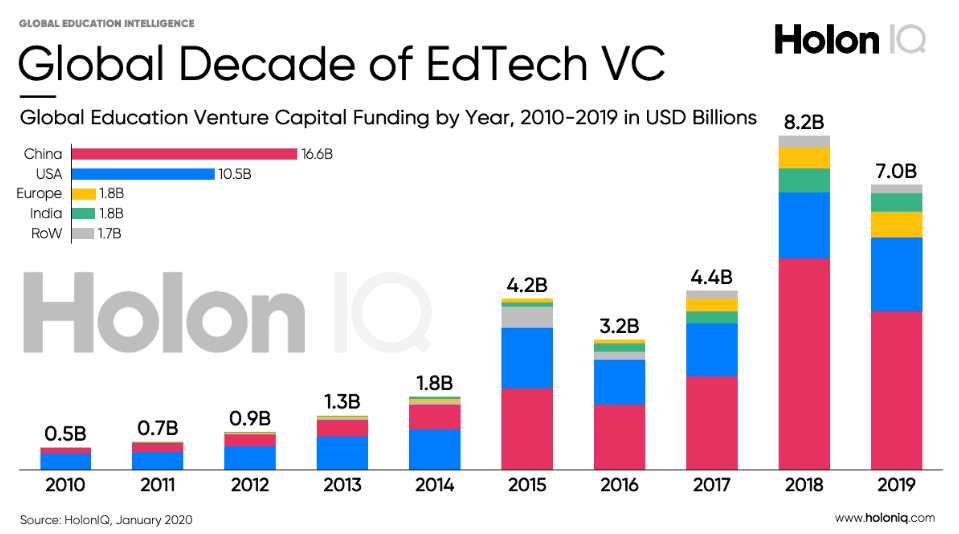
(Image source: holiniq.com)
Most importantly, students and educators seem to be more than warming to the concept of integrating digital learning tools into the education environment. A 2019 report from Gallup and NewSchools Venture Fund called Education Technology Use in Schools: Student and Educator Perspectives revealed a striking consensus among students, teachers, principals, and district administrators in US public schools about the value of ICT in education.
Among students, a significant majority was already utilizing digital learning tools both at school (89%) and outside school (71%). Many students were also predisposed to more frequent use of these tools at school (42%) and outside (34%).
Among educators, digital learning tools garnered impressively high favorability ratings from teachers, principals, and administrators for both current value and increased use in the future. The Gallup study also highlighted several key EdTech factors that resonated with educator constituencies when it came to value.
Educators found that digital learning tools were effective across a range of learning activities, including research or information searches, creating projects, reports, and presentations, and providing practice lessons and exercises. These tools were also rated as “effective” or “extremely effective” by special education teachers for enabling access to content, supporting the development of life skills, and encouraging communication and collaboration among students with special needs and/or disabilities.
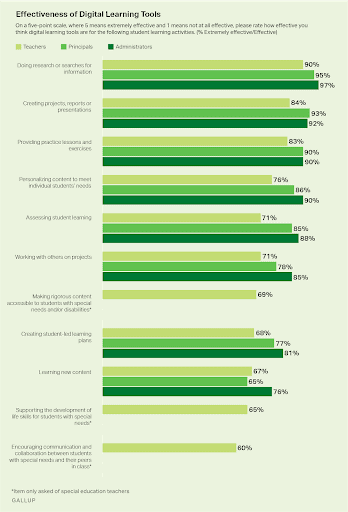
(Image source: gallup.com)
Digital learning tools were also perceived as being more effective than non-digital learning tools for personalizing instruction, engaging students, managing classrooms, and aligning learning with future jobs and careers.
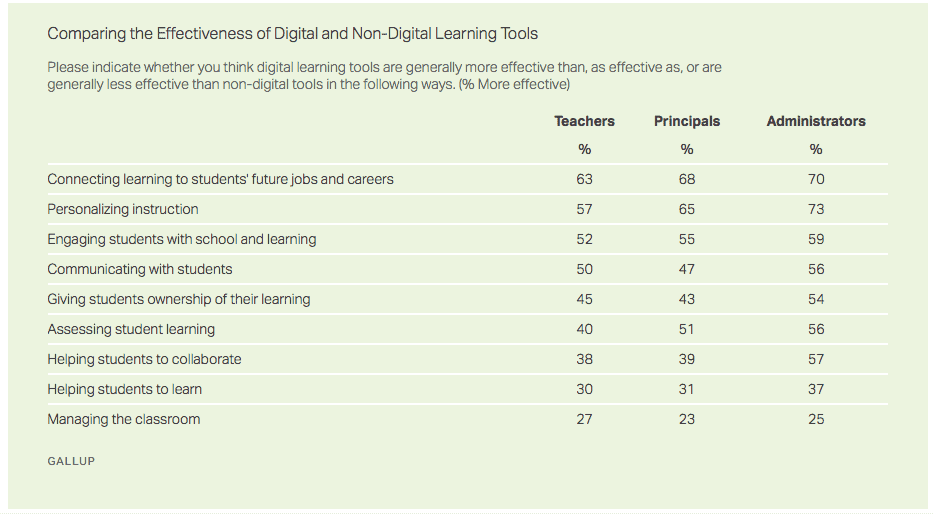
(Image source: gallup.com)
In addition, these tools were seen to provide immediate and actionable data on student progress among a series of other benefits, including ensuring that content is aligned with broader education standards.

(Image source: gallup.com)
There are, however, still several challenges, some associated with the deployment and application of EdTech and others stemming from the macroeconomic and sociopolitical context of global education.
Key ICT in Education Challenges
Despite their optimism and enthusiasm, most educators still think that there is a lack of information about the effectiveness of digital learning tools, however. A more granular analysis of ICT education from education data management and analytics platform BrightBytes also exposed some troubling gaps in EdTech usage.
This study – which covered 48 school districts, more than 390,000 students, and 1.48 million hours of digital app usage – measured real-world performance of EdTech solutions across three variables: investment, engagement, and impact. The findings of this study include these three key insights.
- On average, only 30% of purchased app licenses get used.
- Some apps were more effective than others in converting license purchases into actual intensive usage.
- Irrespective of usage, many low-quality apps had no impact on student learning.
- Average usage across schools and districts was quite low, leading to lower benefits because many schools and/or students were not meeting the minimum usage limits prescribed by solution providers.
As the universe of ICT in education solutions expands, educators will require up-to-date and accessible data on factors like app quality, effectiveness, and ROI, which is the first challenge that the EdTech sector as a whole will have to address.
The second challenge for ICT in education is one of scale – that is, of achieving a critical mass of adoption that will enable scalable and sustainable change in the global education system. Notwithstanding $87 billion investment forecasts, EdTech is still a tiny drop in the ocean of opportunity that is global education.
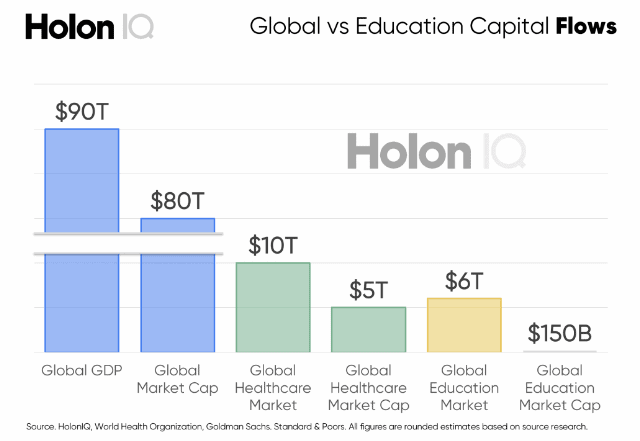
(Image source: holiniq.com)
Education is currently a $6 trillion industry, estimated to grow to $8 trillion by 2025. As of 2018, the share of EdTech is less than 3% of total educational expenditure and is only forecast to grow to 4.4% by the middle of this decade. This under-digitization, coupled with the increasingly limited flows of public funding into education, will create real challenges for the sector to effectively address the systemic issue of global learning poverty at scale.
All of which brings us to the scale of the challenge that ICT in education needs to address.
In 2015, UN member states formally adopted the 2030 Agenda for Sustainable Development, which included SDG 4, a new global education goal. The purpose of SDG 4 was to ensure inclusive and equitable quality education and promote lifelong learning opportunities for all by 2030. Half a decade later, progress towards that goal, according to UN statistics, is far off track. More than half of all children in low- and middle-income countries and nearly 90% of those living in sub-Saharan Africa are unable to read proficiently by age 10. The target, therefore, has now been pared down to a more feasible level of halving learning poverty over the same time frame.
As such, the final challenge for ICT in education is to tackle this pipeline problem. Unless all gateway deficiencies in the education system are addressed, even the most sophisticated interventions, further along, will yield suboptimal results in terms of quantity, quality, and pace of outcomes.
There is little doubt, however, that digital technologies objectively have the potential to disrupt conventional educational systems and facilitate more engaging learning models and targeted outcomes. Here, then, are two emerging learning models – adaptive learning and immersive learning – and the two technologies, AI and XR, that can mainstream these models.

Key Technologies in Education
There are a number of technologies that, together, can have a transformative impact on education. The combination of cloud computing and mobile devices, for instance, has facilitated the anytime/anywhere delivery of learning resources with the cloud eliminating all CAPEX in favor of a scalable pay-as-you-go format. Together, these technologies have paved the way for truly virtual classrooms where the location of either the teachers or the students is irrelevant. The possibilities will only expand to include more computer-intensive learning modules. In the US, Verizon has already announced a new 5G expansion for its Innovative Learning Initiative to ensure that schools “have access to emerging technologies like artificial intelligence, augmented reality, and virtual reality.”
AI and Adaptive Learning
As with most industries, artificial intelligence (AI) is the tent pole technology for the education sector too. And it has the potential to shift, at scale, the teaching paradigm from the longstanding passive, one-to-many model to an adaptive model that enables a more personalized, dynamic, and productive approach to learning.
An adaptive AI system, according to Derek Haoyang Li, Founder of Squirrel AI Learning, performs three continuous functions; one, it tracks and assesses individual students’ interactions, responses, and behaviors in real-time as they progress through the digital learning environment. Two, it uses insights from the assessment to deliver personalized recommendations. And three, it leverages AI to make process-level rather than task-level instructional.
Adaptive learning systems are becoming increasingly sophisticated by the day. For example, researchers at North Carolina State University have designed a multi-task AI model that is more accurate than conventional AI at predicting how students will answer a test question based on their past interactions with a learning environment. Today, Adaptive Learning Platforms are capable of delivering powerful recommendation and prediction features without the hassles of deep integration.
Data, and lots of it, is a key ingredient for the success of any AI-based learning system. Most educational programs have access to large volumes of personal, administrative and pedagogic data that can be leveraged to identify the most effective combination of learning materials, teachers and teaching methods that will deliver the best outcomes for a specific individual’s learning profile.
XR and Immersive Learning
Immersive learning describes a powerful approach to learning that engages the experiential, cognitive, behavioral, and emotional learning centers in the brain. If conventional learning is about transferring knowledge from the teacher to the students, immersive learning focuses on providing students with multisensorial experiences that stimulate them to construct new knowledge themselves. This dynamic and participatory experience helps increase engagement and motivation, simplify understanding, and enable deeper and longer-lasting cognitive associations that enhance retention and recall. It can also be particularly helpful in dealing with the attention deficit engendered by the digital age and help students visualize complex concepts.

Now a new generation of learning technologies are turning to XR (Extended Reality), a catch-all term that covers VR (Virtual Reality), AR (Augmented Reality), and MR (Mixed Reality) to bring immersive experiential learning to the classroom. In fact, it is estimated that XR applications in education will become a $5.3 billion market by 2023.
Today, several XR-based immersive learning solutions cover a wide range of topics, including surgery training for junior doctors, K-12 science delivered as interactive 3D content, and VR-powered interactive laboratory simulations for STEM curricula.
However, there is still a long way to go before XR becomes a mainstream application in education. There are still several challenges that have to be addressed, including high hardware costs, a limited content library, and concerns about return on investment (ROI).
Of course, all this technological potential is only as good as the implementation and integration. So, let’s take a look at a couple of models that educators can use to evaluate EdTech for their contextual educational needs.
Frameworks for Evaluating EdTech
Though ICT in education has the potential to enhance the performance, effectiveness, and efficiency of almost every possible learning environment, different environments are at different stages of tech adoption and may even have significantly diverse educational needs and contexts. One of the most popular frameworks for educators to assess the integration and impact of technology is the SAMR model.
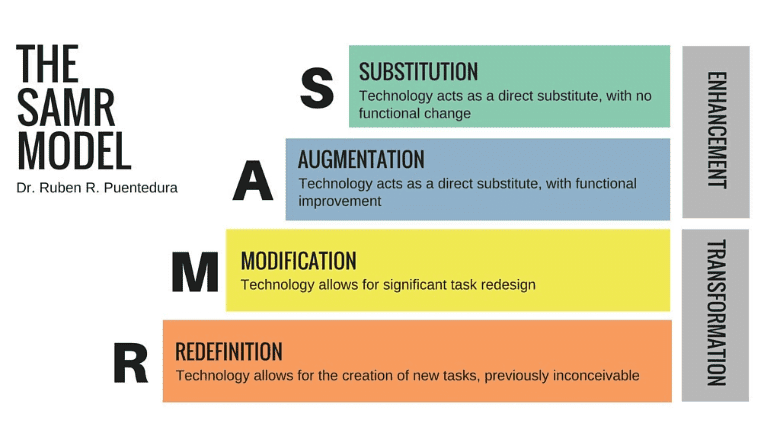
(Image source: pearsoninternationalschools.com)
The SAMR framework plots the impact of technology, from incremental change to radical transformation, across four distinct stages. The first stage, substitution, is as straightforward as switching an analog process, say, reading books, with a digital alternative, say eBooks, with no major functional change whatsoever. In certain contexts, this may be all the technology that is required. The next phase is augmentation to add functionality that would not be possible in an analog model. Together, these phases reference technological enhancements that enable functional upgrades without too much alteration to the status quo.
The final two phases, augmentation, and modification are more transformative in that several aspects of the learning environment are extensively redesigned. For example, modification is usually accompanied by significant task redesign, while redefinition entails a comprehensive overhaul of the learning environment with technology that enables new experiences that would have been previously unfeasible.
The SAMR framework is a useful resource for educators to incorporate ICT in education based on an assessment of their prevalent technological infrastructure, their future learning requirements, and then choosing the right technologies that would transition them smoothly to the next phase on their continuum. Several other frameworks are available, including TPACK (Technological Pedagogical Content Knowledge), TIM (Technology Integration Matrix), and Triple E.
Final Thoughts
The global education sector is currently in a state of flux marked by EdTech innovations on the one hand and learning poverty on the other. Though ICT in education has the potential to address many of the issues facing the industry, it still constitutes an almost insignificant proportion of current educational expenditure.
However, when used effectively, EdTech has the power to transform traditional learning environments and radically improve outcomes. It also has the potential to make education more inclusive, accessible, and economical for marginalized constituencies.
EdTech is not an alternative to conventional pedagogic principles and practices, though. In order to be effective, ICT in education has to be integrated in a way that reinforces and augments traditional educational processes while providing the digital tools required to address some of the key deficiencies of the existing system.
Summary:
ICT in Education
The concept of EdTech – “education” and “technology” – has evolved considerably since the days when things like free laptops and massive open online courses (MOOCs) were pretty much the focal point of the “ICT in education” discussion. Information and communications technology (ICT) is an extensional term for information technology (IT) that stresses the role of unified communications and the integration of telecommunications (telephone lines and wireless signals) and computers, as well as necessary enterprise software, middleware, storage, and audiovisual systems, that enable users to access, store, transmit, and manipulate information. If these initial experiments proved anything, it’s that ICT in education had to provide an ecosystem of complementary solutions and services, as opposed to a series of discrete interventions that would help institutions disrupt education. It would be fair to state that the educational technology sector has survived, and even thrived since the suboptimal returns of these initial set-piece programs. Venture capital investments in EdTech have risen fourteen-fold since the beginning of this decade, from $500 million in 2010 to $7 billion in 2019. Over the next ten years, the sector is forecast to attract over $87 billion in investments, almost triple that of the prior decade. Most importantly, students and educators seem to be more than warming to the concept of integrating digital learning tools into the education environment. A 2019 report from Gallup and NewSchools Venture Fund called Education Technology Use in Schools: Student and Educator Perspectives revealed a striking consensus among students, teachers, principals, and district administrators in US public schools about the value of ICT in education.





